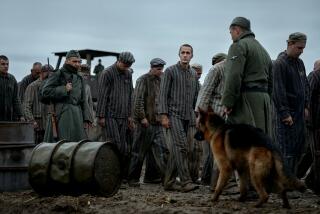Silver Screenâs Role in WWII
âHollywood Commandos,â a documentary premiering Friday on the American Movie Classics channel, salutes a group of unsung heroes of World War II. The Army Air Corps First Motion Picture Unit helped win the war--not through bullets or bombs, but through the powerful weapon of film.
Between 1942 and 1945, the First Motion Picture Unit churned out more than 300 training films and documentaries. The production values rivaled those of major studios and featured such top talent of the day as William Holden, James Stewart, Alan Ladd, Ronald Reagan, Clark Gable, John Ford, William Wyler and John Huston.
âIt was the studio system in uniform,â says âCommandosâ producer Gregory Orr, whose father, Bill Orr, appeared in several of the unitâs movies.
The majority of these films, though, have either been destroyed or locked away in government warehouses and havenât been seen since World War II. The films were forgotten, Orr says, âbecause people were just tired of the war. Even in popular movies, it took several years after the war until Hollywood could make war movies people wanted to see.â
These films both âsaved peoplesâ lives and cut down on training time,â says Orr, who also is developing a feature on the First Motion Picture Unit. âA study was done after World War II by a UCLA professor on the value of film education and he found that the military training films cut down training time by as much as 25%.â
It was Air Force Chief Gen. H.H. âHapâ Arnold who realized the value of film as an educational tool. âAt that time the Air Force was struggling to get out from under Army control,â Orr says.
âWith World War II it became a brand new department and Gen. Arnold wanted his Air Force to be unique,â Orr says. âSo I think within the films, his philosophy is there in terms of what kind of organization [the Air Force is]: We are high-tech. We take care of each other.â
The First Motion Picture Unit was launched by Warner Bros. head Jack Warner who secured much of the unitâs enlisted talent from his studio. Warner brought over one of his short-subject producers, Owen Crump, to supervise production.
The unit was stationed at the now-demolished Hal Roach Studios in Culver City, which was nicknamed âFt. Roach.â Because of its regular hours and relaxed atmosphere, the unit was often made the butt of jokes by other enlisted men, as well as the members themselves.
According to director Richard Bare, who specialized in films about the B29 plane, the unit was a self-deprecating lot. âWe had an expression there--we all got the distinguished coffee medals for 20 trips to the PX,â he says, laughing. âWe made fun of ourselves to keep people from making fun of us.â
The combat camera units were a separate entity trained at a Boy Scout camp in Laurel Canyon. âThere were approximately 16 combat camera units,â relates former combat photographer Dan McGovern.
âEach particular unit had a specific task. My specific task with the 8th unit was documenting B17s. My specific support was to William Wylerâs production of âThe Memphis Belle.â â McGovern and his unit were also involved in the production of the documentaries âTarget for Todayâ and âTarget Germany.â
McGovern, who was wounded in action in Europe, is thrilled that audiences will finally get to learn about the First Motion Picture Unit. âItâs about time they are giving some recognition to the forgotten cameramen of World War II.â
âHollywood Commandos,â which is narrated by Ron Reagan Jr., features interviews with numerous veterans of the unit including Bare, McGovern, Crump, actors DeForest Kelley, Craig Stevens and Bill Orr, and Disney animator Frank Thomas.
The documentary also includes fascinating clips from several of these films, which seem far less dated than most of the patriotic features Hollywood produced for commercial audiences during World War II.
The 1942 short, âWinning Your Wings,â one of the few of these movies released in theaters, was Hollywoodâs most successful recruiting film. Air Corps cadet Jimmy Stewart stars in this guided tour of the Air Force, which was directly responsible, according to the documentary, for 100,000 enlistment volunteers.
âThat is what convinced the Air Force to make more of [these films],â Orr says.
Crumpâs âLearn and Liveâ was the first full-length feature from the unit. The film, which addresses safety issues, was so successful it spawned the sequels âLearn and Live in the Desert,â âDitch and Liveâ and âLearn and Live in the Jungle.â
âResisting Enemy Interrogation,â which also had a theatrical release, is considered the unitâs finest training film and was nominated for an Oscar for best feature documentary in 1944. ââThat was a great film,â recalls Bare.
Lloyd Nolan and Kent Smith star in the cautionary tale about an American crew taken to a German interrogation camp where they are separated from each other and are tricked by the Germans into revealing information.
Not every film dealt with planes, bombs and guns. âThree Cadets,â which was requested by the Medical Corps, offers a sobering lesson in the consequences of untreated venereal disease. John Ford even made a VD film, âSex Hygiene,â which was so grossly explicit it reportedly made the Oscar-winning director physically ill when he watched it.
âSpecial Film Project 152â is one of many top-secret films that provided the U.S. and its allies with reconnaissance information on Japan to aid bombers in identifying their targets.
âThey actually built a miniature Japan on a sound stage,â Orr says, âand flew cameras over to simulate the bombing runs. They would then be rushed out to pilots in the Pacific so they would see where they were supposed to go.â
Orr believes the best example of the type of films the First Motion Picture Unit produced is âReconnaissance Pilot,â which features a strong performance from William Holden. In the film, Holdenâs character wanted to be a fighter pilot and is bitter heâs flying a reconnaissance plane taking photographs.
âIt really follows his change of heart,â Orr says. âIt dealt very well with identifying with a man who, like so many people in the service, was stuck with a job that he didnât want, and how to change your outlook. I think it did a very good job in making you understand your part in the war. Itâs a really great example of a film that quietly and effectively does its job.â
*
* âHollywood Commandosâ airs Friday at 5 and 9:30 p.m. on AMC and repeats May 26 at 6 and 9:30 p.m.
More to Read
Only good movies
Get the Indie Focus newsletter, Mark Olsen's weekly guide to the world of cinema.
You may occasionally receive promotional content from the Los Angeles Times.











